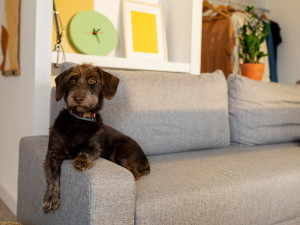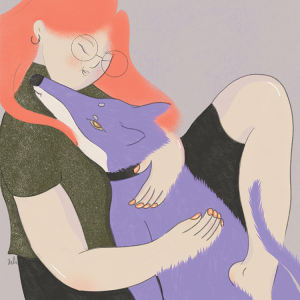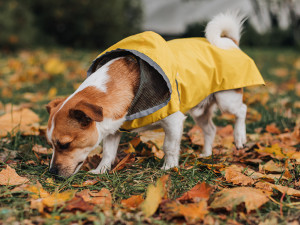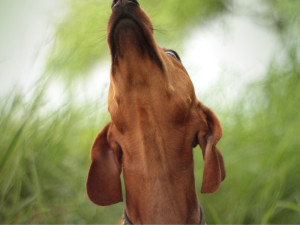Why Is My Dog Obsessed With Sniffing Me Every Time I Come Home?
From your mood to where you’ve been, your dog’s sniffing tells them a lot about you
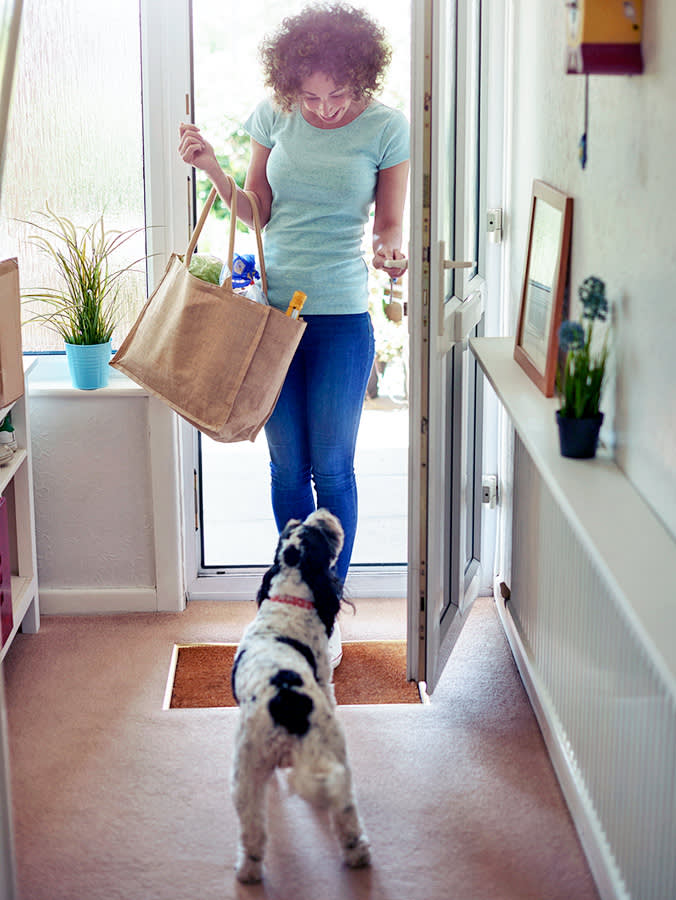
Share Article
You walk through the door, and suddenly, your dog is all over you, sniffing like a TSA agent on high alert. After a brief hello and a snuggle, it’s nose to your toes, a quick check of your hands, then investigating all areas of your clothing – leaving no pocket unchecked. You might even feel as if they’re trying to collect forensic evidence from the time since you last saw them.
But why are our dogs so quick to turn into Sherlock Holmes, repeating the daily scent ritual each time you return home? While pat-downs are used to detect threats and keep us safe on our travels – for our dogs, is this investigation just curiosity, or is there something deeper at play?
This ritual is a fascinating blend of science, communication and bonding time. Your dog isn’t just being nosey – in fact they might just be decoding the story of your day, one sniff at a time.
The superpower of a dog’s nose
Can you imagine experiencing the world primarily through your nose; instead of through sight, sound or touch? A dog’s sense of smell is estimated to be 10,000–100,000 timesopens in new tab more sensitive than our own (depending on individual breed). And with the part of a dog’s brain that’s dedicated to processing information within scent particles being proportionally about 40 times larger than that of us humans, you can see why for dogs – the nose is what knows.
A dog’s remarkable ability to sniff subtle chemical aromas that reveal information about another dog – for example what diet they’re fed, their gender, mood–state and even health status – comes from the approximately 300 millions receptors within their olfactory (scent) system.
In addition to their powerful sense of smell, dogs have a specialised organ known as the vomeronasal organ or Jacobson’s organ. You might have missed this one, as it hides between the nasal cavity and roof of the mouth. This organ is specifically adapted to detect pheromones, and plays a vital role in social interactions, which enables dogs to interpret chemical changes from both us humans and other dogs – such as stress – and respond appropriately.
To add to their special qualities, no dog’s nose is the same – the pattern of their nose is as unique as a human fingerprintopens in new tab.
Why do dogs sniff you when you get home?
No matter where you've been – shopping, at the office or visiting a friend – does your dog give you an enthusiastic sniff when you get home, gathering all the important intel about your day? When you walk back through the front door your scent is going to tell them a lot about your comings and goings – not only where you’ve been, but who with – and, most importantly for some dogs, what you’ve eaten.
Other dogs
Have you ever joked, while interacting with another dog, that your own dog will be jealous when you get home and they work out you’ve been giving their attention away? Whether you’ve been fraternising with a dog they dislike or making pals with another pooch, that dog’s scent will be left on you through the oils from their coat on your hands, from where they’ve rubbed against your legs or loose hairs attached to your clothing.
Your mood state
We mentioned earlier that special Jacobson’s organ that dogs have, helping them to detect subtle hormonal changes in humans. Dogs can smell changes in cortisol levels (the stress hormone), adrenaline (excitement) or even pheromonesopens in new tab that suggest illness or fatigue.
If your dog is struggling to gauge how you’re feeling, you may see them use a tongue flick or lip lick where they’re gathering scent to send it to the Jacobson’s organ for better investigation. Knowing how we’re feeling allows our dogs to predict how we might next interact with them – do we need space, are we about to play or is it time for a snooze on the sofa?
Regrouping and bonding
Just as you may hug a family member when you’re regrouping at the end of a busy day apart, your dog’s sniffing is a way for them to re-familiarise themselves with you and stay connected. You may even see your dog licking you to either gather more scent or to actually place their own scent back onto you, to normalise scent across the household.
Instinctual behaviour
Sniffing and finding out about the world through scent is an instinctual behaviour. It allows the dog to find out if there’s a threat incoming, food to be had, and if you’re a trusted source of comfort. Our domesticated dogs can still be seen to act in an instinctive manner – such as sniffing to make sure you’re still ‘one of the pack’.
Out of habit
A lot of the things dogs do come from habit forming – being an established part of their routine. It may be that they started this investigative behaviour when they were in a more anxious phase of their life – such as during adolescence – when they needed more reassurance when you arrived home and it’s just become the thing they now do. If they nuzzle in and give you some cuddles during this sniffy time, you might have also reinforced this behaviour – giving them affection in return – so now it’s just become an important part of your regrouping activities.
Why some dogs are more intense about it
Certain breeds, for example scent hounds such as Beagles or Basset Hounds, are naturally going to be more driven by scent and the processing of the information sniffing provides – it’s in their DNA to sniff! You may therefore see in multi-dog households, that different breeds of dogs act quite differently around scent.
A dog that is more anxious, especially one that struggles to relax during solo time – experiencing some form of separation anxiety – is more likely to seek out reassurance on your return home. For dogs with attachment issues, their excessive sniffing provides a hit of happiness – basking in your scent – as well as allowing themselves to refamiliarise themselves with their most trusted humans.
If you greet your dog with as much enthusiasm as they show you upon your return home, they will come to expect this little lovefest. They’ll eagerly anticipate your arrival and see it as a special moment to celebrate – rewarded with extra cuddles and attention for their sniffing behaviour.
Should you stop your dog from sniffing you?
When it comes to your dog frisking you for new smells on your return home, if you’re not bothered by it, then you can continue to let them do it. However, if they apply the same approach to visiting guests, you might need to manage their initial interactions by putting them on a lead or behind a dog gate.
If your dog is getting a little too enthusiastic in their greetings, you might also be finding it too much to handle. Perhaps you can’t even take your shoes or coat off as your dog is attached to you! In this case, it can be useful to teach your dog an alternative behaviour to do – such as fetching you a toy or moving away from you to a special ‘place’ such as a mat or step of the stairs. You can then go and greet them there once they’ve had a moment to calm down. You could also choose a set amount of time your dog has to give you the once over with their nose – then have a toy you throw away to create space.
It’s also worth noting that if your dog has suddenly changed in its sniffing behaviour – especially if they seem quite fixated on a certain part of your body or smell – then it could potentially indicate a change in your own healthopens in new tab or theirs. If in doubt, book a physical wellbeing check for both dog and human!
Embrace the ‘sniffing ritual’
The next time your dog gives you a thorough sniff-down after you walk through the door, remember – it’s not just about curiosity, it’s building your connection. They’re catching up on the daily news – of which you are the headline. They’re using their best tool – their nose – to better understand your world… they’re not being nosey, they’re being a good doggy detective.
Resources:
Jenkins, Eileen K, et al. “When the Nose Doesn’t Know: Canine Olfactory Function Associated with Health, Management, and Potential Links to Microbiota.opens in new tab��” Frontiers in Veterinary Science, 29 Mar. 2018.
Choi, Hyeong In, et al. “Study on the Viability of Canine Nose Pattern as a Unique Biometric Marker.opens in new tab” Animals (Basel), 25 Nov. 2021.
Jendrny, Paula, et al. “Canine Olfactory Detection and Its Relevance to Medical Detectionopens in new tab.” BMC Infectious Diseases, 19 Aug. 2021.
Tucker, Ian. “Diseases That Dogs Can Detect.opens in new tab” The Guardian, Guardian News and Media, 4 Nov. 2018.

Caroline Wilkinson
Caroline Wilkinson is a Certified Animal Behaviourist. As the Founder of digital pet coaching service Barket Place, Caroline has a passion for improving connections between human and hound, with a focus on relationships and reduction of stress for canines living in a human world.
Related articles
![Illustration of a woman hugging a dog]()
Is That... Stress Your Dog Smells?
A study finds that your pup can tell – er, smell – when you’ve been doom-scrolling
![Dark brown dog sitting on a gray couch in a living room]()
Turns Out Dogs Can... Smell Time
There’s no time like the present, according to your pet
![Jack Russell Terrier in a yellow raincoat walks through the autumn park.]()
What Can Your Dog Smell?
There’s a reason that sweet little nose is always pressed to the ground
![Chihuahua puppy wearing a native Indian necklace sitting next to a lemon]()
Does Your Dog Hate Citrus?
It’s the one food most dogs can't stand. Here’s why – plus, how to use their dislike of citrus to your advantage
![Close up shot of a brown dog sniffing upward out of frame with blurry grass in background]()
Crotch Sniffing: Crude Or Customary?
Is it time to teach your dog some boundaries?

